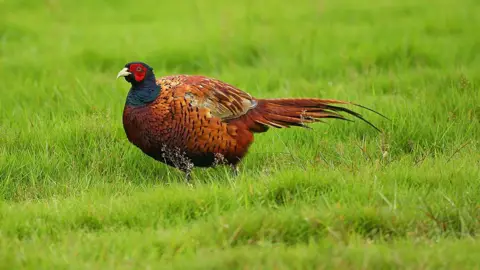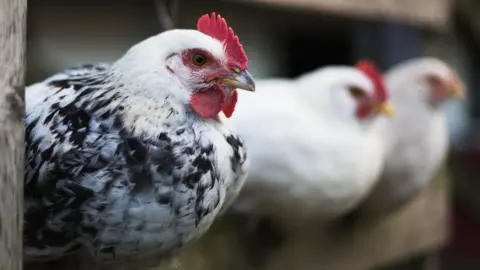Bird Flu: Anglesey pheasants to be culled after confirmed cases
 Getty Images
Getty ImagesBird flu has been confirmed in pheasants at a premises in north Wales, the Welsh Government has said.
The Chief Veterinary Officer for Wales confirmed the presence of the H5N8 strain at a premises in Penysarn near Amlwch on Anglesey.
The Welsh Government said a temporary control zone had been immediately imposed around the site.
Mortality of birds on the premises is high and all those surviving in the affected group will be culled.
This is the first confirmation of the disease in Wales in the winter of 2020-21, the government said.
It follows confirmation of several outbreaks of Avian Influenza in other parts of the UK this winter.
The temporary control zone came into force on 27 January at 21:00 GMT and will run until the declaration is withdrawn or amended by further declaration, the Welsh Government said.
New measures came into force in Wales, England and Scotland on 14 December, making it a legal requirement for all bird keepers to keep their birds in enclosures and to follow strict biosecurity measures.
The Food Standards Agency has said on the basis of the current scientific evidence, avian influenza poses a very low food safety risk for UK consumers.
 Science Photo Library
Science Photo Library"This case of Avian Influenza in pheasants on Anglesey serves to reinforce the need for all keepers of poultry and other captive birds to practice the very highest levels of biosecurity," said Christianne Glossop, the Chief Veterinary Officer for Wales.
Poultry keepers with more than 50 birds must be on the poultry register, and those with fewer are strongly advised to register their birds to enable disease control.
It means they will be immediately informed in the event of an avian disease outbreak.
What is bird flu?
Bird flu, or avian flu, is an infectious type of influenza that spreads among birds.
The NHS says it can affect humans - but only in very rare cases.
To date there have been no cases of humans being infected with avian influenza in the UK, the Royal Society for the Protection of Birds (RSPB) said.
 PA Media
PA MediaBird flu is spread by close contact with an infected bird, whether it is dead or alive.
There are two forms of the virus - high pathogenicity (HPAI) and low pathogenicity (LPAI), The Health and Safety Executive (HSE) says.
Pathogenicity indicates the severity of the disease if the bird contracts the virus.
